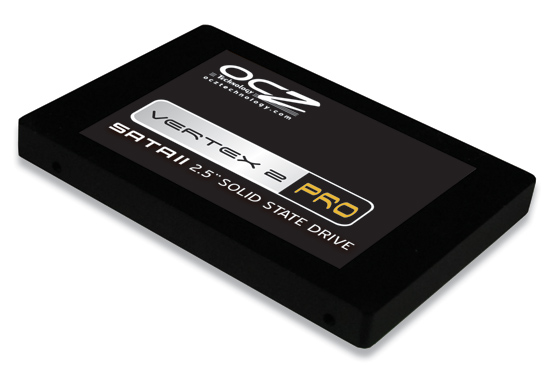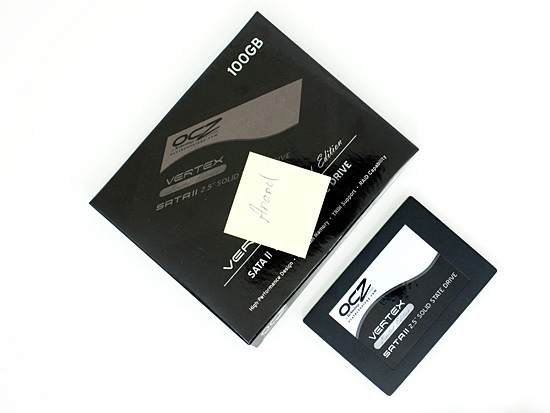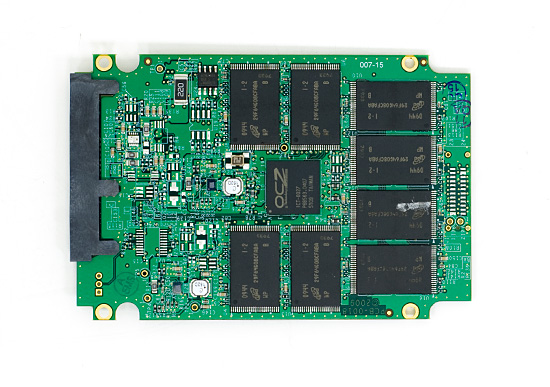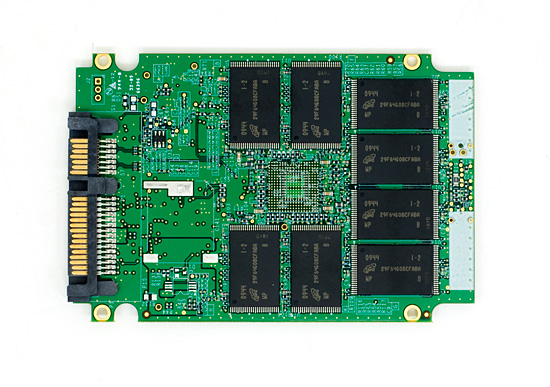OCZ’s Vertex Limited Edition Review & SSD State of the Union
by Anand Lal Shimpi on February 19, 2010 12:00 AM EST- Posted in
- Storage
Back in December I previewed OCZ’s Vertex 2 Pro, the first drive I’d tested to use SandForce’s SF-1500 controller. As you may remember, the controller works in a radical way - by reducing the amount of data written to flash it improves performance and longevity, at the cost of controller/firmware complexity. Not a bad tradeoff for a company trying to sell you expensive SSD controllers. If you want to know more about how it works, I'd suggest consulting my Vertex 2 Pro Preview. If you want to know how SSDs work, take a look at the SSD Relapse.

RIP...
The drive made an impressive showing, easily besting any other MLC SSD I’d ever tested. Unfortunately, it was pre-release hardware, with no known price and no set release date. Not to mention that the company who made the controller was shipping largely unproven technology with an unknown amount of reliability/validation testing.
Since then two things have happened.
First, my SandForce SF-1500 pre-release sample straight up died on me. No warning, no errors, just no data. It only took a couple of weeks worth of real world use to make it happen, but this is why I prefaced the preview with the following:
“Ultimately, the task of putting these drives to the test falls on the heads of you all - the early adopters. It’s only after we collectively put these drives through hundreds and thousands of hours of real world usage that we can determine whether or not they’re sponge-worthy. Even Intel managed to screw up two firmware releases and they do more in-house validation than any company I’ve ever worked with. The bugs of course never appeared in my testing, but only in the field in the hands of paying customers. I hate that it has to be this way, but we live in the wild west of solid state storage. It’ll be a while before you can embrace any new product with confidence.
And it only gets more complicated from here on out. The old JMicron drives were easy to cast aside. They behaved like jerks when you tried to use them. Now the true difference between SSDs rears its head after months or years of use.”
And second, the OCZ Vertex 2 Pro as a product has been canned. Not because of the issue that lead to the untimely death of my drive, but because the SF-1500 controller is just too expensive. I knew that it was going to be pricey at the time I wrote the article, but apparently OCZ thought it could bring the price down by the time it shipped. Needless to say, that didn’t happen.
Instead of the Vertex 2 Pro, OCZ will be shipping the regular Vertex 2 based on SandForce’s slower SF-1200 controller. This SSD will carry a pricetag similar to present day Vertex drives, but hopefully offer better performance. For enterprise customers OCZ will ship the Vertex 2 EX based on the SF-1500 with SLC flash and a ginormous, quarterly-budget depleting pricetag (to be determined). The consumer MLC SF-1500 based Vertex 2 Pro is gone forever.
Here’s where the Vertex Limited Edition comes in:

Despite its name, the Vertex Limited Edition is an MLC SandForce SF-1500 SSD (technically it's a SF-1200/SF-1500 hybrid like the Vertex 2 Pro, but that's a separate issue entirely). It's basically the Vertex 2 Pro with one big caveat - there are only a limited number of these drives being made - 5,000 to be exact. Once they're all gone, that's it.

My Vertex LE is Serial #1. Ebay, here I come!
OCZ apparently got a sweetheart deal on an early batch of SF-1500s. This is the same controller from the Vertex 2 Pro in December, but with an updated firmware (RC1). These are the first drives shipping with RC1 of the SF-1500 firmware and will presumably not die on you after a couple of weeks. While I’ve heard that they may not be enterprise worthy, they are apparently fit for desktop use. OCZ has said that in its internal testing there haven't been any cases of a bricked Vertex LE. The same was not true during the Vertex 2 Pro test period. Now here comes the problem.

The OCZ Vertex Limited Edition. That's a SandForce SF-1500 controller under that OCZ logo in the middle.
I literally just received my drive 24 hours ago. Just like its ancestor, this thing will be put through the wringer for the coming weeks and months. However long it takes to make sure it is worthy of your dollars. The problem is that these drives are limited in quantity, chances are they will all be gone by the time I figure out whether or not they are worthy of a glowing recommendation.
What makes the Limited Edition so special is that because of OCZ’s great pricing on the SF-1500 the 100GB Vertex LE will be selling for $399 ($829 for the 200GB version) - roughly the same price as a 128GB Indilinx based Vertex drive. And in case you’re wondering, yes it performs identically to the Vertex 2 Pro I previewed last year:
| OCZ Vertex LE 100GB | OCZ Vertex 2 Pro 100GB | |
| 4KB Random Write | 51.2 MB/s | 50.9 MB/s |
| 2MB Sequential Write | 252.7 MB/s | 252.0 MB/s |
| 4KB Random Read | 52.0 MB/s | 51.3 MB/s |
| 2MB Sequential Read | 265.3 MB/s | 265.3 MB/s |
| PCMark Vantage Overall | 16827 | 16767 |
| PCMark Vantage HDD | 39288 | 39970 |
| AT Bench - Light | 884 IOPS | 890 IOPS |
| AT Bench - Heavy | 701 IOPS | 705 IOPS |
| AT Bench - Gaming | 319 IOPS | 319 IOPS |
For roughly the same price per GB you’d pay for an Intel X25-M G2, you’re getting a much faster drive. The only issue is that its reliability is unproven. To calm your fears, OCZ is selling the Vertex LE with a 3 year warranty.

Barring any unforeseen issues, the drives will go on sale next week. Risky business.
I should note that we’ve seen vendors get quite opportunistic with hot SSDs in limited quantities before. There’s always the chance that these Vertex LEs will sell for more than their MSRP.
The nifty OCZ Toolbox I showed in my Vertex 2 Pro preview presently doesn’t work with the Vertex LE. The application looks for SandForce in the controller id, which is absent from these unbranded SF-1500 controllers that SandForce unloaded. By the time the drives ship though there should be a custom version of the OCZ Toolbox ready. TRIM is supported and works perfectly under Windows 7.
Unlike the Vertex 2 Pro sample I tested, the Vertex LE doesn’t have the ungodly expensive capacitor on its PCB. As I mentioned before, these aren’t designed to go into servers and thus the supercap won’t be missed. Performance on the drive is great and I haven’t had any issues thus far in my testing, but there’s a long road ahead of me.
The RC1 firmware is brand new to me. I’ll be putting the drive through its paces but given that the units will go on sale next week I decided to share my initial thoughts today rather than wait.










83 Comments
View All Comments
neoflux - Sunday, February 21, 2010 - link
part number is K9HCG08U1M-PCB00, but still can't find a size in nm.neoflux - Monday, February 22, 2010 - link
Further research shows me that no one knows what manufacturing process size these actually are, which I find strange. No reviews include the information, there are no manufacturing spec sheets, etc. Only that they are lead-free and have 48 pins, haha.This all must makes me more curious. How does no one know?
eldiablopotato - Sunday, February 21, 2010 - link
Both the OCZ & Crucial SSDs are nice, since my motherboard can't do 6Gbps can anyone recommend which SSD to get? I'm thinking Crucial SSD, but then again I'm no expert on SSDs like Anand. :PFeedback welcomed.
nivek - Sunday, February 21, 2010 - link
OCZ says they can't get any more sandforce controllers at a low price point. But how does OWC get the same controller for their Mercury Extreme Enterprise SSD. OWC 100GB SSD is priced the same as OCZ Vertex LE 100GB!http://eshop.macsales.com/shop/internal_storage/Me...">http://eshop.macsales.com/shop/internal_storage/Me...
Per Hansson - Sunday, February 21, 2010 - link
Just curious about the missing capacitor, will there not be a big risk of dataloss incase of power outage?Do you know what design changes where done to get rid of the capacitor, where any additional components other than the capacitor removed?
Because it can be bought in low quantities for a quite ok retail price of £16.50 here;
http://www.tecategroup.com/ultracapacitors/product...">http://www.tecategroup.com/ultracapacitors/product...
sjobal - Sunday, February 21, 2010 - link
Hi Anand,I'm curious to know what SSD is most suitable for a mac. Since OSX does not support TRIM, some sort of garbage collection has to be done within the drive (firmware) or a software tool has to be available for OSX.
Is this something you'll look into in forthcoming reviews?
Best regards!
AnnonymousCoward - Saturday, February 20, 2010 - link
Anand,How can you benchmark in so many different ways, and yet end up with hardly any relevant information? All those PCMark graphs don't tell me squat. Your AnandTech Storage Bench is flawed, since (as your last article found) the SandForce uses compression and IOPS don't equal bandwidth! Why does the user care about IOPS?? Do they care about IOPS of their graphics cards? Or CPU?
With CPUs, you measure things like encoding time and game framerates. Things that matter!
This is the 3rd time I'm posting this. Refer to the last time: http://tinyurl.com/yjcr5vm">http://tinyurl.com/yjcr5vm
Zoomer - Sunday, February 21, 2010 - link
It's a waste of time to do what you're suggesting. The point of SSDs is to improve the user response time.Encoding time? It would likely be virtually identical due to the modern pre-fetching algorithms in place.
Game framerates won't really be affected since the average of 3 runs is taken. After the first run, most everything will be cached, either in hardware or in software by the os in mem.
In the real world, you would expect to see less dips in fps (min fps will be higher), assuming it is a fresh first run.
bradley - Sunday, February 21, 2010 - link
The point is germane. New SSD benchmarks are required to measure real world performance. Some of the current benchmarks end up limited to measuring nothing more than cache speed. IOPS is impractical and demonstrates nothing indicative regarding real world performance.the Problem with Write IOPS - in flash SSDs
http://www.storagesearch.com/problem-write-iops.ht...">http://www.storagesearch.com/problem-write-iops.ht...
erple2 - Sunday, February 21, 2010 - link
Ordinarily, I'd agree with you. However, the point of the article was to point out the problems with "older" benchmarks that would simply look at, in a vacuum, IOPS of a drive was inconsistent at best, and misleading at worst. In the case of Anand's testing methodologies, you see that the IOPS numbers he comes up with are, in fact, the "worst case scenario" listed for SSD's in the article you linked to.Until the giant Meltdown of SSD's in Anand's article (http://www.anandtech.com/storage/showdoc.aspx?i=35...">http://www.anandtech.com/storage/showdoc.aspx?i=35..., testing methodologies that benchmark reviewers were using were definitely perfectly suited to the problems with SSD's, namely the write-erase cycle being specifically excluded from the benchmarks. That indicated the main problem storagesearch.com referred to in the above linked article.
Anand has since changed his benchmark methodology for all SSD's to be a "polluted" SSD - he does not simply wipe the drive clean, then benchmark. He first fills the drive with data, then does a format (which does NOT wipe the drive clean - you still have the write-erase cycle to contend with), then runs benchmarks.
The other thing to look at is that the benchmarks that Anand looks at are, in fact, consistent. Saying that one drive attains 600 IOPS on "Anand's light StorageBench" where another attains 500 IOPS _ON THE SAME BENCHMARK_ does, in fact, give you a reasonably accurate comparison. The trouble you'll get into is if you state "Drive X gets 5000 IOPS, but Drive Y gets 9000 IOPS", not mentioning the actual benchmark used, or even worse, cherry-picking the benchmarks to favor the particular Drive. Then, you have to dig down and figured out whether the benchmarks that gave you "5000 IOPS" was, in fact, properly executed - is that really indicative of the performance of the drive, or only in a very tightly controlled environment to maximize performance numbers? However, that's a question you always have to look at regardless of what you're testing, be it video cards (3D Vantage doesn't give you an accurate picture of how well the card will perform in some particular scenario), CPU's (SPECint or SPECfp give you minimal information about how a CPU performs in a large database environment) or other devices.
So really, I think that the point the article in storagesearch is hammering at you should be wary of reading more into generic IOPS as a benchmark for these SSD's as is simply stated.
So, in conclusion, I disagree about 80% with what you have written.
(minor "edit"):
So I've re-read the GGP post - while it is true that IOPS as a number means nothing to me, it also winds up being true that posting a Bandwidth number would also be more or less worthless to me - what is important is the general ranking of these devices in the same benchmark. The benchmark is measuring the _relative_ performance of each of the drives in the same sequence of tests. Taking conclusions like "this drive gets 600 in a benchmark and that one gets 400 in another benchmark" ultimately fails.
(BTW, Anandtech staff, please fix the fact that I can't use any "rich" text in these posts)